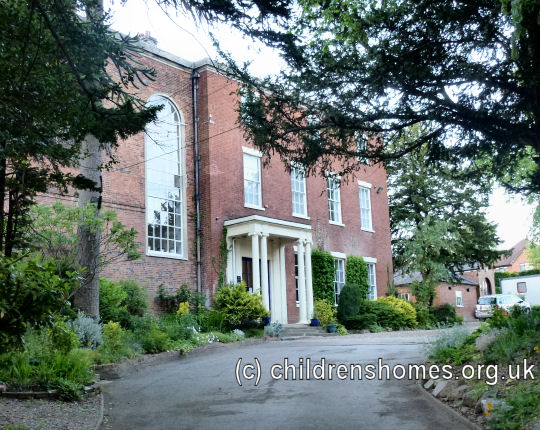Montefiore House School for Jewish Girls, Stoke Newington, London
The Montefiore House School for Jewish Girls was founded in 1905 at 69 Stamford Hill, Stoke Newington, London N16. The house, formerly a family residence, was a square substantial building standing back from the main road at the top of Stamford Hill. In addition to various internal alterations and redecoration, an outside iron staircase was erected as an emergency means of escape. The stable were converted for use by the School. The property also had a very good garden.
On January 9th, 1906, the establishment was certified as an Industrial School, allowing it to receive girls committed by magistrates. Voluntary inmates were also accepted upon payment of 9s. plus £3 for an outfit. The premises could accommodate up to 30 girls aged from 6 years upwards. The superintendent was Mrs E Nasch, with Miss Easterbrook as schoolmistress. The School's initial inmates were transfers from another establishment, and these caused a good deal of trouble and anxiety, one subsequently being sent to a Reformatory.
On August 18th, 1909, the official capacity of the main School was increased to 66 places.
An inspection report in 1910 noted that all parts of the house were in order and beautifully clean. A granolithic playground had recently been added. Classroom performance in singing, composition, recitation, mental arithmetic and geography was pronounced as good. With regard to industrial training, the girls demonstrated needlework of the finest quality, in addition to which, the speed with which the work was done was remarkable. Quite young children were able to cut out and put together garments. Cookery was taught by a member of the staff. Laundry work of a good variety was beautifully handled. In physical training, Swedish drill was taken outdoors when the weather allowed. Dancing and games were taught by a lady friend of the school. Numerous garden parties and outings were enjoyed, and regular walks are taken. The general health of the girls was remarkably good. Two new girls had had scabies, and there were two girls with obstinate ringworm. Teeth were well cared for. There had been a small amount of impertinence and disobedience, chiefly in the kitchen, but the girls generally gave very little trouble. There was a mark system in operation with rewards and privileges dependant on good conduct. It was said that one of the greatest punishments at the School was to deprive a girl of her work.
In 1920, an Auxiliary Home for the School was opened at 45 Great Prescott Street (now Prescot Street), Aldgate, London E1. The premises, known as Sara Pyke House, had originally been opened in 1900 as a lodging house providing accommodation and protection to respectable Jewish girls and women arriving at the port of London en route to relatives, friends, or employers. The Home was named after the late wife of the establishment's benefactor, Mr Joseph Pyke, and had replaced an older building on Tenter Street, Aldgate. On April 13th, 1920, the premises were certified for use as an Auxiliary Home, with accommodation for 26 girls. The establishment provided supervised hostel-style accommodation for girls leaving, or on licence from, the main School. In 1924, the Home relocated to 99 Highbury Quadrant, Highbury, London N5, and was certified on April 17th, 1924, with accommodation for 15 girls, aged 14 to 16 years at their time of admission. In July, 1929, the Home's capacity was increased to 18 places.
From 26th May, 1930, the main School was certified to extend its admissions to include boys under the age of eight, as long as they were removed before reaching the age of ten.
In 1933, Montefiore House became an Approved School, one of the new institutions introduced by the 1933 Children and Young Persons Act to replace the existing system of Reformatories and Industrial Schools. It was now certified to accommodate a total of 56 girls aged from 10 to 15 at their date of admission. Small boys could also still be received in exceptional circumstances. The superintendent in 1935 was Mrs Falk.
At the outbreak of the Second World War, the School was evacuated to the premises of The Elms Approved School at Market Harborough, Leicestershire.

The Elms, Market Harborough,2013. © Peter Higginbotham
In February, 1943, the Montefiore School relocated again to 21 Ridgmont Road, St Albans, Hertfordshire. It is thought to have ceased operation n the late 1940s.
The Stamford Hill building no longer exists and Montefiore Court flats now stand on the site. Neither of the Auxiliary Home premises survives.
Records
Note: many repositories impose a closure period of up to 100 years for records identifying individuals. Before travelling a long distance, always check that the records you want to consult will be available.
- University of Southampton Special Collections, Hartley Library, University of Southampton, Highfield, Southampton SO17 1BJ.
Holdings include:
- Montefiore House: Minutes of the General Committee (1912-40); Attendance register; Punishment register.
- Sara Pyke House: Minutes (1904-7, 1937-46).
Bibliography
- Higginbotham, Peter Children's Homes: A History of Institutional Care for Britain's Young (2017, Pen & Sword)
- Mahood, Linda Policing Gender, Class and Family: Britain, 1850-1940 (1995, Univeristy of Alberta Press)
- Prahms, Wendy Newcastle Ragged and Industrial School (2006, The History Press)
Links
- None noted at present.
Except where indicated, this page () © Peter Higginbotham. Contents may not be reproduced without permission.


